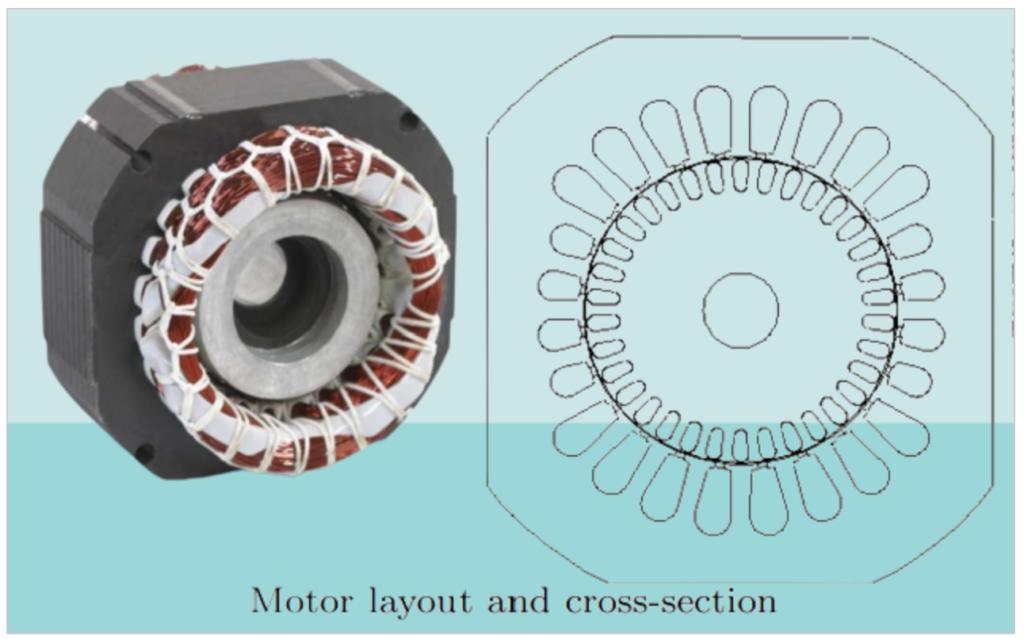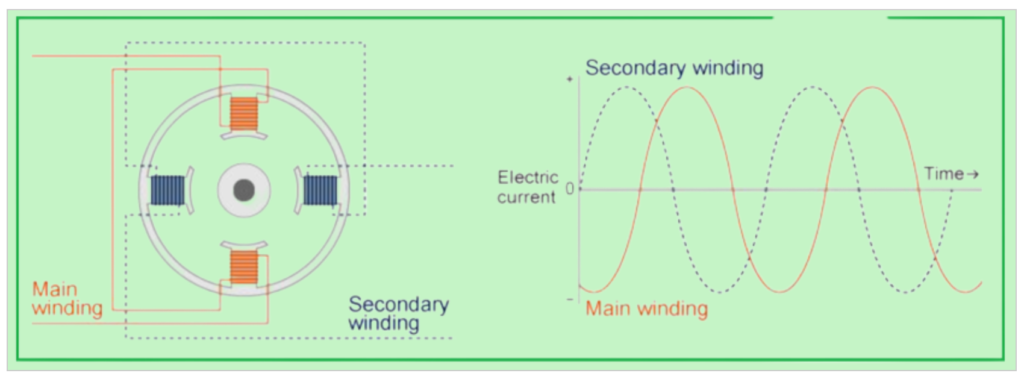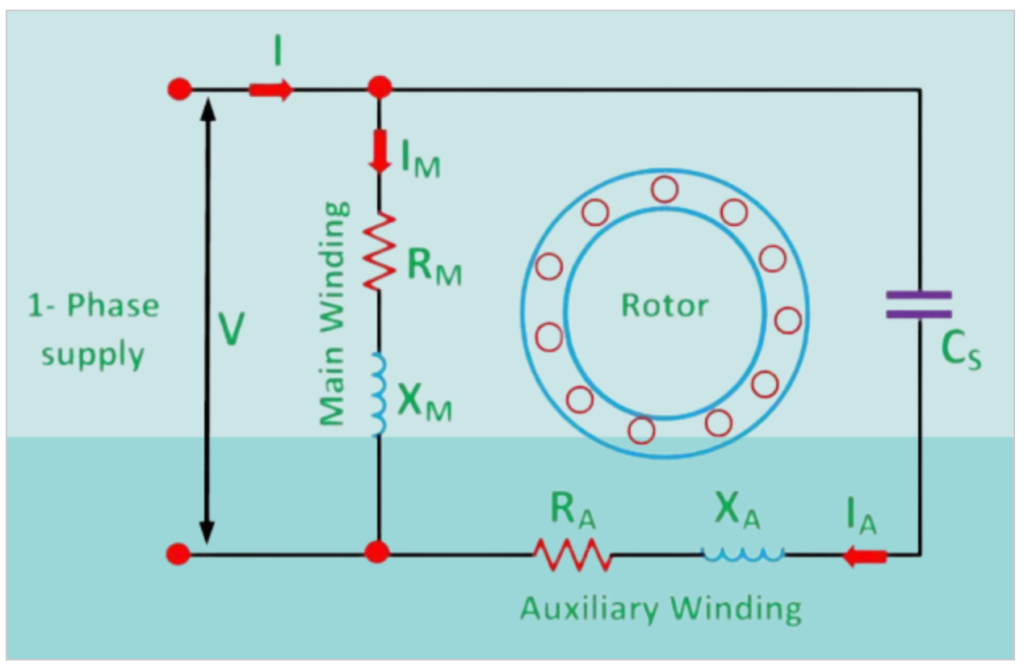The permanently split capacitor (PSC) motor is a commonly used single-phase motor in various applications. Unlike some single-phase motors that use a starting winding and a starting capacitor to provide the initial torque required to start the motor, PSC motors utilize a different approach.
What is Permanently Split Capacitor (PSC) Motor:
Here are the key characteristics and considerations related to PSC motors:
- No Separate Starting Capacitor: PSC motors do not have a separate starting capacitor or a starting switch. Instead, they have a run-type capacitor that is permanently connected in series with the start winding. This design eliminates the need for a starting capacitor.
- Auxiliary Winding: The start winding in a PSC motor functions as an auxiliary winding once the motor reaches its running speed. The run capacitor remains connected in series with this winding during both starting and running modes.
- Limited Starting Torque: PSC motors typically provide lower starting torques compared to motors equipped with a separate starting capacitor. The starting torques of PSC motors typically range from 30% to 150% of the rated torque. As a result, PSC motors may not be suitable for applications that require high starting torque.
- Efficiency vs. Starting Torque: The optimization of PSC motor design often involves a trade-off between maximizing starting torque and maximizing efficiency. Some optimization techniques, such as genetic algorithms, can help find the right balance between these objectives.
- Design Parameters: Optimizing a PSC motor involves adjusting various design parameters, including the turns ratio of the auxiliary and main stator windings (a), the magnetic flux density in the air gap of the motor (Bδ), and the axial length of the stator core (L).
- Core Material Influence: The choice of core material also plays a significant role in the magnetic flux density and, consequently, the motor’s performance. Different core materials can impact the motor’s efficiency and torque characteristics.
- Optimization Methods: Researchers often use optimization methods like genetic algorithms and particle swarm optimization to find the best combination of design parameters for a PSC motor that maximizes its performance.
- Real-World Application: Here is the study we mentioned is applied to an actual motor model, the FMR 35/6 PSC motor produced by MicronTech. The primary objective is to increase the motor’s output torque, improve its operating characteristics, enhance efficiency, and potentially improve its ability to drive loads effectively.
PSC motors are commonly used in various applications, and optimizing their design involves balancing factors like starting torque, efficiency, and design parameters. Researchers often employ mathematical models and optimization methods to achieve the desired motor performance improvements.

In this specific case, Genetic Algorithms (GAs) have proven to be effective in quickly converging towards the optimal solution. This efficiency is attributed to several factors:
- Limited Parameters: The motor design has a relatively small number of varied parameters that need optimization. This simplifies the search space and allows GAs to explore it more efficiently.
- Single Objective Function: The mathematical model of the motor has only one objective function, meaning there is a single criterion to optimize. GAs excel in finding optimal solutions for single-objective optimization problems.
The accuracy of the motor model is of utmost importance in this study. The mathematical model is derived based on the exact geometry of the motor. To ensure its precision, the basic motor model (BM) is validated through experiments.
Furthermore, the accuracy of the optimized model is verified by comparing its output results, including motor currents, speed, and torque, with the results obtained from a Simulink model of the motor, which serves as a benchmark.
Finite Element Analysis (FEA) is applied to both the basic and optimized motor models. FEA, based on the Finite Element Method (FEM), examines the impact of design modifications on various aspects of the motor’s electromagnetic behavior:
- Magnetic Flux Density: The analysis assesses changes in the magnetic flux density within the motor’s cross-section and the air gap. This provides valuable insights into the electromagnetic processes taking place within the machine.
- Core Saturation: FEA helps identify areas within the motor construction where the flux density approaches the point of core saturation. Detecting these regions is crucial for optimizing the motor’s performance.
The study employs GAs for efficient optimization, validates the motor model through experimentation, and verifies the accuracy of the optimized model through detailed comparisons with simulation results. FEA, specifically FEM, plays a vital role in assessing the impact of design modifications on magnetic flux density and core saturation, providing valuable insights into the motor’s electromagnetic behavior.
Working Principle of Permanently Split Capacitor (PSC) Motor:
To operate a motor using the standard single-phase power supply found in homes, a method for initiating the motor’s rotation is required. A Permanent Split Capacitor (PSC) motor accomplishes this by incorporating distinct main and secondary windings, as illustrated in the diagram. The main winding is directly connected to the power supply, while the secondary winding is linked via a capacitor.
When the power supply is activated, electricity initially flows through the main winding and subsequently, with a brief delay attributed to the capacitor, through the secondary winding. This time difference in the currents flowing through the main and secondary windings results in a phase shift, causing their waveform peaks to alternate between the two windings. This generates a torque, or rotational force, that sets the motor in motion.

Construction of Permanently Split Capacitor Motor:
The Permanent Split Capacitor (PSC) motor is a type of single-phase motor commonly used in various applications. It features a cage rotor and two windings: the main winding and the auxiliary winding, which is similar to the windings found in Capacitor Start and Capacitor Start Capacitor Run motors. However, unlike those motors, the PSC motor has only one capacitor, denoted as C, which is permanently connected in the circuit during both starting and running conditions.

Here are some key points about Permanent Split Capacitor motors:
Operation: The PSC motor operates as a balanced two-phase motor, as the auxiliary winding is always in the circuit. This design results in uniform torque production and quiet, noise-free operation.
PSC Motors Speed Control:
Permanent Split Capacitor (PSC) motors can be adapted for variable speed applications, and their speed can be controlled by adjusting the input voltage. An autotransformer is employed to achieve variable input voltage.
However, when operating at low voltage levels, these motors tend to produce limited starting torque, and their speed becomes sensitive to changes in voltage.
Another approach for speed control involves regulating the frequency of the input power supply. An increase in frequency results in higher speed, while a decrease leads to slower speed.
In this method, the AC power supply is converted into a DC supply using a controlled rectifier. Subsequently, the DC supply is transformed back into an AC supply with the desired frequency.
For instance, if the AC supply is transformed into a 40 Hz frequency, the motor will operate at a slower speed. Conversely, converting the AC supply to 60 Hz will cause the motor’s speed to increase. Using this method, the motor’s speed can be controlled within a range of 20% to 110% of its full-load speed.
Advantages:
- No Starting Switch: Unlike some other motor types, the PSC motor doesn’t require a centrifugal switch for starting, simplifying its design and reducing wear and tear.
- High Efficiency: These motors are known for their high efficiency.
- Power Factor: The permanent connection of the capacitor in the circuit leads to a high power factor, which is beneficial for power quality.
- Pullout Torque: PSC motors typically have a higher pullout torque compared to some other single-phase motors.
Disadvantages & Limitations:
- Capacitor Type: PSC motors use paper capacitors due to their continuous running nature. Electrolytic capacitors, which are more compact and cost-effective, are not suitable for continuous operation. Paper capacitors can be larger and more expensive than electrolytic capacitors with similar ratings.
- Starting Torque: PSC motors tend to have low starting torque, which means they may struggle to start loads that require high torque.
PSC Applications:
Permanent Split Capacitor motors find applications in various devices and equipment, including:
- Fans and blowers in heaters and air conditioners.
- Refrigerator compressors.
- Office machinery.
Overall, PSC motors are known for their efficiency and reliable operation in a wide range of applications, especially those with relatively low starting torque requirements.